
Atelier Štěpán - The Temple in Litomyšl will awaken in a new way after forty years
Brno/Litomyšl - A tomb that opens electronically, a floor tattooed with bronze inscriptions, or a viewing terrace between the church towers. Such modifications have been proposed by the significant architect of sacred buildings Marek Jan Štěpán and his wife Vanda Štěpánová for the reconstruction of the Piarist church of the Finding of the Holy Cross in Litomyšl. It will open to the public on September 14 after more than forty years. Besides the repair of the church, which has been deteriorating since 1968, there are numerous architectural innovations awaiting believers, culture lovers, and tourists.
For over forty years, the closed church of the Finding of the Holy Cross in Litomyšl served as a warehouse and parking lot. Now this unique baroque gem is coming back to life and is set to become the center of cultural life in Litomyšl once again. It will not remain "just" a church - it will uniquely combine sacred, tourist, and cultural activities.
“The question of what to do with such a damaged space was actually the hardest of all,” describes architect Marek Jan Štěpán, who, together with his wife Vanda Štěpánová, is the author of the project. According to him, giving the church new functions was essential. “Without it, this space wouldn't be viable in today's times,” adds the architect.
Interview with Marek J. Štěpán
What you won't see anywhere else in the church — The church will not only serve for worship but also for organizing concerts, theatrical performances, and other cultural events. Visitors will be able to view a permanent exhibition of the diocese's sacred art with the inspiring title Angels on the Hill, as well as other exhibitions. Tourists will enjoy the view from the terrace between the church towers, walk through the church via a newly inserted bridge across the transept, or admire the uniquely preserved sacristy. Contemporary artists will also be able to exhibit in the tomb, which is operated by an electric lid.
“However, we did not want the church to turn into a museum. Its viability would then not last long. Something similar happened in Russia, where museums of atheism were established in churches. Therefore, we studied the history of the Piarists as well as the church itself and tried to connect the reconstruction as much as possible with the tumultuous history of the place,” describes Marek Jan Štěpán.
The floor is adorned with bronze inscriptions that recall the most important events of the site. The gray painting also reminds us of the four devastating fires that the church underwent. “Many inscriptions also remain in their places. For example, behind the organ, inscriptions from all periods of the church's 300-year history remain on the wall, left by boys who hid there. The benches also tell the history of the church - names and years are carved into them. Those who sit in them can read what someone perhaps carved into them 200 years ago,” says architect Štěpán.
The city secured a record grant for the repairs — The project is part of the reconstruction of the entire castle hill. The city of Litomyšl received the largest European grant in its history for this – 400 million crowns. The reconstruction of the church alone cost 80 million crowns, while the rest of the grant went to the repair of another 10 buildings on the castle hill - the reconstruction of the Piarist college, repair of the riding school, carriage house, stables, horse barn, park, and the first and upper courtyards, as well as the reconstruction of the Castle Brewery and the outer castle.
“I am glad that we managed to preserve one of the most precious pearls of Czech baroque for future generations. The total investment is visible at first glance and is a testament to the quality of Marek Jan Štěpán's architectural design and a prime example of the mastery of Czech restorers. I believe that the effort was worth it because of the preservation of the Piarist church,” said Litomyšl Mayor Michal Kortyš.
The church was reconsecrated by Cardinal Vlk in June this year, with the ceremonial opening of all revitalized buildings on the castle hill taking place on September 14. At 2 PM, there will be a ceremonial handover of the keys, but the program will be varied from the morning - from guided tours to craft demonstrations and exhibitions of historical vehicles, as well as puppet shows and a concert by the Spirituál kvintet group.
Under the guidance of architect Marek Jan Štěpán, newly built churches such as the Church of the Holy Spirit in Ostrava, Šumné, and Zubří have emerged. As the chief architect, he contributed to the significant liturgical adjustments of St. Nicholas Cathedral in České Budějovice, designed the lighting of St. Vitus Cathedral at Prague Castle, and is also the author of the project for a new church building to be realized in Brno - Lesná.
The church in numbers — The usable area of the church is over 2,000 m²; internal length 62 m; width 35.5 m; height at the crossing of the naves 25.6 m. The surface area of the internal paintings approaches 10,000 m². The work on the project took architects around 4,000 hours.
History of the Church of the Finding of the Holy Cross — The Piarist church of the Finding of the Holy Cross was constructed between 1714-1722 by the Italian builder Giovanni Battista Alliprandi and was completed after his death in 1720 by František Maxmilián Kaňka. The name “Finding of the Holy Cross” is taken from a painting by the prominent Italian painter Francesco Trevisani, which hung in the church until it was destroyed by fire in 1775. Today, a copy of it is in the church.
1713 — The prominent Italian architect Giovanni Battista Alliprandi measures the construction site
1714 — Laying of the foundation stone
1716 — The old church of the Virgin Mary is demolished at the site of the new construction
1730 — Completion of the decoration and construction of the church
1728 — The original Marian dedication is changed to the Finding of the Holy Cross, relocating Trevisani's painting from the side chapel to the main altar
1735 — First fire (two towers burned down)
1775 — Second tragic fire (the main altar with the precious painting, evangelist St. John, two confessionals, the altar of St. Vaclav, both chapels, the organ, sacristy, and gallery destroyed)
1814 — Fire (the altar of the Virgin Mary, confessionals, and organ destroyed)
1883 — Fourth of the devastating fires (main altar destroyed)
1968 — The church is closed by official authority
2010 — Minister of Culture Václav Reidelbauch signs a decision in the church, based on which a grant for the reconstruction of the castle hill was allocated to the city of Litomyšl
2011 — The reconstruction begins
For over forty years, the closed church of the Finding of the Holy Cross in Litomyšl served as a warehouse and parking lot. Now this unique baroque gem is coming back to life and is set to become the center of cultural life in Litomyšl once again. It will not remain "just" a church - it will uniquely combine sacred, tourist, and cultural activities.
“The question of what to do with such a damaged space was actually the hardest of all,” describes architect Marek Jan Štěpán, who, together with his wife Vanda Štěpánová, is the author of the project. According to him, giving the church new functions was essential. “Without it, this space wouldn't be viable in today's times,” adds the architect.
Interview with Marek J. Štěpán
What you won't see anywhere else in the church — The church will not only serve for worship but also for organizing concerts, theatrical performances, and other cultural events. Visitors will be able to view a permanent exhibition of the diocese's sacred art with the inspiring title Angels on the Hill, as well as other exhibitions. Tourists will enjoy the view from the terrace between the church towers, walk through the church via a newly inserted bridge across the transept, or admire the uniquely preserved sacristy. Contemporary artists will also be able to exhibit in the tomb, which is operated by an electric lid.
“However, we did not want the church to turn into a museum. Its viability would then not last long. Something similar happened in Russia, where museums of atheism were established in churches. Therefore, we studied the history of the Piarists as well as the church itself and tried to connect the reconstruction as much as possible with the tumultuous history of the place,” describes Marek Jan Štěpán.
The floor is adorned with bronze inscriptions that recall the most important events of the site. The gray painting also reminds us of the four devastating fires that the church underwent. “Many inscriptions also remain in their places. For example, behind the organ, inscriptions from all periods of the church's 300-year history remain on the wall, left by boys who hid there. The benches also tell the history of the church - names and years are carved into them. Those who sit in them can read what someone perhaps carved into them 200 years ago,” says architect Štěpán.
The city secured a record grant for the repairs — The project is part of the reconstruction of the entire castle hill. The city of Litomyšl received the largest European grant in its history for this – 400 million crowns. The reconstruction of the church alone cost 80 million crowns, while the rest of the grant went to the repair of another 10 buildings on the castle hill - the reconstruction of the Piarist college, repair of the riding school, carriage house, stables, horse barn, park, and the first and upper courtyards, as well as the reconstruction of the Castle Brewery and the outer castle.
“I am glad that we managed to preserve one of the most precious pearls of Czech baroque for future generations. The total investment is visible at first glance and is a testament to the quality of Marek Jan Štěpán's architectural design and a prime example of the mastery of Czech restorers. I believe that the effort was worth it because of the preservation of the Piarist church,” said Litomyšl Mayor Michal Kortyš.
The church was reconsecrated by Cardinal Vlk in June this year, with the ceremonial opening of all revitalized buildings on the castle hill taking place on September 14. At 2 PM, there will be a ceremonial handover of the keys, but the program will be varied from the morning - from guided tours to craft demonstrations and exhibitions of historical vehicles, as well as puppet shows and a concert by the Spirituál kvintet group.
Under the guidance of architect Marek Jan Štěpán, newly built churches such as the Church of the Holy Spirit in Ostrava, Šumné, and Zubří have emerged. As the chief architect, he contributed to the significant liturgical adjustments of St. Nicholas Cathedral in České Budějovice, designed the lighting of St. Vitus Cathedral at Prague Castle, and is also the author of the project for a new church building to be realized in Brno - Lesná.
The church in numbers — The usable area of the church is over 2,000 m²; internal length 62 m; width 35.5 m; height at the crossing of the naves 25.6 m. The surface area of the internal paintings approaches 10,000 m². The work on the project took architects around 4,000 hours.
History of the Church of the Finding of the Holy Cross — The Piarist church of the Finding of the Holy Cross was constructed between 1714-1722 by the Italian builder Giovanni Battista Alliprandi and was completed after his death in 1720 by František Maxmilián Kaňka. The name “Finding of the Holy Cross” is taken from a painting by the prominent Italian painter Francesco Trevisani, which hung in the church until it was destroyed by fire in 1775. Today, a copy of it is in the church.
1713 — The prominent Italian architect Giovanni Battista Alliprandi measures the construction site
1714 — Laying of the foundation stone
1716 — The old church of the Virgin Mary is demolished at the site of the new construction
1730 — Completion of the decoration and construction of the church
1728 — The original Marian dedication is changed to the Finding of the Holy Cross, relocating Trevisani's painting from the side chapel to the main altar
1735 — First fire (two towers burned down)
1775 — Second tragic fire (the main altar with the precious painting, evangelist St. John, two confessionals, the altar of St. Vaclav, both chapels, the organ, sacristy, and gallery destroyed)
1814 — Fire (the altar of the Virgin Mary, confessionals, and organ destroyed)
1883 — Fourth of the devastating fires (main altar destroyed)
1968 — The church is closed by official authority
2010 — Minister of Culture Václav Reidelbauch signs a decision in the church, based on which a grant for the reconstruction of the castle hill was allocated to the city of Litomyšl
2011 — The reconstruction begins
The English translation is powered by AI tool. Switch to Czech to view the original text source.
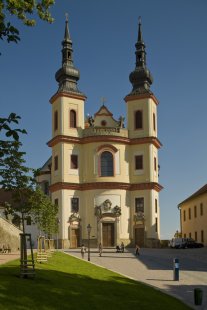

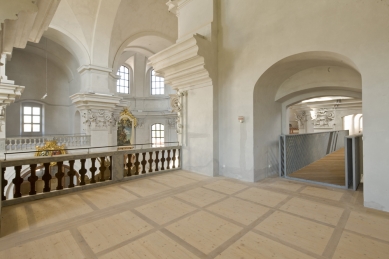
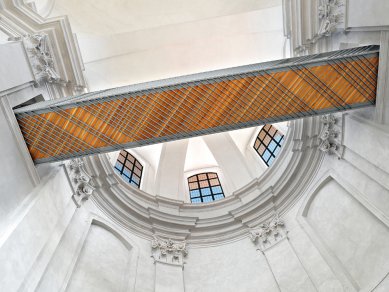
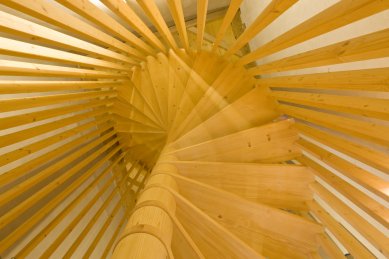
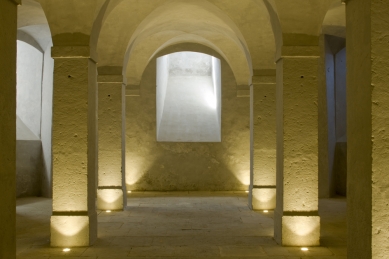
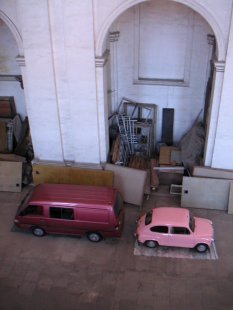
0 comments
add comment
Related articles
0
07.01.2015 | Litomyšl is considering how to improve the acoustics of the renovated temple
0
01.12.2014 | The Piarist Church in Litomyšl is adorned with a modern glass column
0
10.10.2014 | The glass work in the church of Litomyšl will be without the laser cross
0
11.09.2014 | With Mark J. Štěpán about the reconstruction of the Litomyšl church












